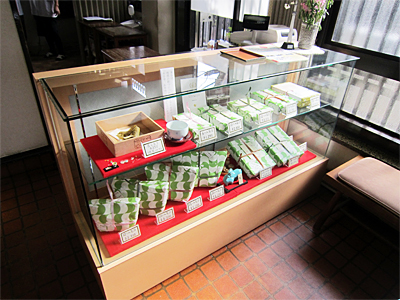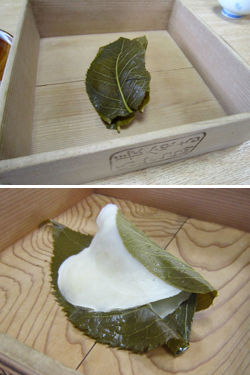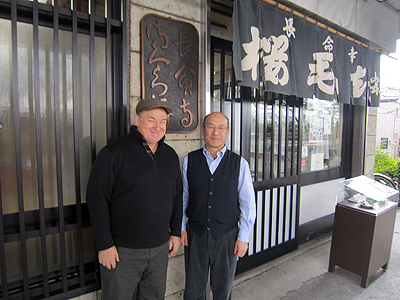 |
セインさん。今日も前回に続いて、隅田川の東岸にあるお店を訪ねます。長命寺という古いお寺の隣にある「長命寺桜もち」。享保2年(1717)創業ですので、まもなく300年になるという老舗中の老舗です。「長命寺の桜もち」は、ご存じでしたか。
Thayne-san, today we’re going to visit another shop on the east bank of the Sumidagawa River. It’s next to an old temple called Chomeiji, and the shop’s name is Chomeiji Sakuramochi. It was founded in 1717, meaning its history spans nearly 300 years, and making it one of the oldest shops even within the Toto Norenkai association. Have you heard of it? |
|
|
 |
もちろん! 実は、大好物なんです。でも、いただき物ばかりで、お店に入るのは初めてです。こんにちは。
Of course! In fact their sakuramochi is one of my favorites. But despite enjoying sakuramochi, so much I’ve never been inside the shop. Hello. |
|
|
|
 |
|
|
| (山本) |
こんにちは、セインさん、コンシェルジュさん。
Yamamoto-san:Good afternoon Thayne-san and Concierge-san!. |
|
|
 |
はじめまして、山本さん。今日は楽しみに来ました。ものすごく長い歴史を持ったお店なんですね。アメリカなんて、創業された1717年にはまだこの世になかったんですから。
Yamamoto-san, it’s great to meet you. I’ve been looking forward to our visit today. Your shop has such a long history. The United States wasn’t even a country when your shop was founded in 1717. |
|
|
| (山本) |
(笑)。まずは、おかけください。桜もちをお出ししましょう。
Yamamoto-san:Well, please sit down. I’ll bring you some sakuramochi. |
|
|
  |
うれしい!
That’d be wonderful! |
|
|
|
 |
|
|
 |
ほかのお店の桜もちとは、姿形からして違いますね。大きな3枚の葉でしっかり包んである。これは、創業の頃から同じですか?
These have a different shape than the sakuramochi you find at other shops. They’re wrapped tightly in three large leaves. Have you done it this way since you first opened? |
|
|
| (山本) |
はい。初代の山本新六は長命寺の門番だったのですが、一番大変だったのが、桜の落ち葉の掃除だったそうです。なにしろ、隅田川沿いの土手は江戸時代からのお花見の名所。でも桜は落葉樹ですから、秋になると掃いても掃いても落ちてくる。それで、ため息をついていた新六ですが、ある時、この桜の葉を利用することを思いついた。塩漬けにして餅でも包んだら参拝客に売れるんじゃないかと。
Yamamoto-san:We have. The first generation owner, Yamamoto Shinroku, was a gatekeeper at Chomeiji and apparently the hardest thing about the job was cleaning up the fallen cherry tree leaves. The embankment along the Sumidagawa River has been a famous spot for cherry blossom viewing since the Edo Period. Of course, cherry trees are deciduous, and in the autumn no matter how much you rake, there are always still fallen leaves on the ground. Taking a breather from raking one day, Shinroku thought maybe there was some way to use the cherry leaves. He wondered if the temple couldn’t pickle the leaves, use them to wrap mochi, and sell that to visitors. |
|
|
 |
塩漬けにした桜の葉3枚でしっかりと包み込むので、餅が乾かないんですね。香りもいいし、これは評判になりますね。
By wrapping the mochi tightly in three pickled sakura leaves, it won’t dry out. It gives off a nice aroma, too. You can tell this would be popular. |
|
|
| (山本) |
はい。おかげさまで、長命寺の門前で売り出すと、どんどん有名になってやがて江戸名物と呼ばれるほどになりました。創業から100年ほど後の文化7年(1824)の史料には「1年間の桜の葉の漬け込みが31樽。1樽に桜の葉が約2万5000枚入るので、葉の数は77万5千枚あった」と記されています。つまり単純計算で、約38万7500枚の桜もちが、売れた勘定になります。
Yamamoto-san:That’s right. We started selling them in front of the Chomeiji gate, and they became increasingly popular, eventually being called one of the local specialties of the city of Edo. In 1824, about 100 years after our shop first opened, our records say we were making 31 barrels of pickled cherry leaves a year, and about 25,000 leaves fit in one barrel, for a total of 775,000 leaves. That means we sold about 387,500 sakuramochi. |
|
|
 |
すごい! そのままずっと儲けてきましたか?
Wow! And you’ve been that profitable all along? |
|
|
| (山本) |
いえいえ(笑)。いい時もあれば、そうはいかない時もあります。父は戦争にも行きましたし、戦災で店が焼けたりもしました。何度も何度もピンチを乗り越えて、という感じです。都心にないから、やってこられたのかもしれません。
Yamamoto-san:Not quite. We’ve had good times and bad times. My father went off to fight in the war, and during that time, the shop was destroyed when Tokyo was bombed. It feels like we just barely managed to overcome crises time and again. We’re probably lucky we aren’t located in central Tokyo. |
|
|
 |
中のさくら餅はどうやって作っているんですか?
How do you make the sakuramochi itself? |
|
|
| (山本) |
小麦粉を水で溶き、鉄板の上に落として小判型に伸ばして焼きます。いわば小さなクレープです。その餅皮であっさりとした甘みの自家製餡を包んで、それを桜の葉で包んでみ出来上がりです。
Yamamoto-san:We mix flour with water and roll it into oval shapes on a grill, and bake them like mini crepes. That becomes the mochi skin, and we fill each one with a lightly sweetened red bean paste of our own recipe. Finally, we wrap it in the sakura leaves. |
|
|
 |
お餅、本当においしいですね、小麦のおいしさなんですね。それにしても、今でもオートメーションではなく、一つ一つ生地を流して焼いているなんて、驚きました。
Mochi sure is delicious. It’s the flour that makes it so good. But I’m surprised to hear you still roll the dough for each one by hand before baking, rather than doing everything by machine. |
|
|
 |
桜の葉は、ここで漬けているんですか?
Do you pickle the sakura leaves here? |
|
|
| (山本) |
いえ、静岡の業者さんにお願いしています。オオシマザクラという品種の桜で、大きくてやわらかな葉を取ります。塩漬けにすると、やがて発行してクマリンという芳香物質が出て、あの独特の香りがするようになるんです。うちには塩漬けにしたものが届くので、それを1枚1枚洗って、品質を確かめてから桜もちを包んでいます。
Yamamoto-san:No, we have that done in Shizuoka. We use leaves from the Oshimazakura tree, which are large and tender. The pickling process brings out an aromatic substance called coumarin, which gives it that unique smell. After the pickled leaves are delivered to us, we wash each one and inspect them for quality before using them to wrap the mochi. |
|
|
 |
丁寧な仕事をしておられるんですね。一度、伺いたかったんですが、この葉っぱ、お餅と一緒に食べるのはマナー違反でしょうか。
I can see you’re very careful in your work. I wanted to ask, is it rude to eat the leaves together with the mochi? |
|
|
| (山本) |
お餅と餡のおいしさを味わっていただきたいので、まずは葉っぱを取って召し上がってください。そうすると、桜の葉のいい香りも、しっかり楽しんでいただけます。
Yamamoto-san:We want you to enjoy the taste of the mochi and red bean paste as well, so it’s best to remove the sakura leaves before eating the sakuramochi. That way you can really appreciate the lovely aroma of the leaves. |
|
|
 |
ああ、おいしい。でも、取った桜の葉も食べちゃいますけれど。
Mmm, that’s yummy. But now I’m going to eat the sakura leaves too. |
|
|
| (山本) |
もちろん、どうぞご自由に。(笑)。以前、小沢昭一さんからこんな小噺を教えていただきました。 「ある人が、桜もちを皮(葉)ごと食べるのを見て、隣にいた人が“旦那、皮をむいて食べた方がいいですよ”。そこで“あ、そうですか”と、川の方を向いて食べた」
Yamamoto-san:Go right ahead. I once heard a story told by Ozawa Shoichi which went like this: A man was eating sakuramochi, leaves and all, when the servant next to him noticed this and said, “Master, when eating sakuramochi you should remove the leaves.” (In Japanese, “kawa o muku.”) The man replied, “Is that right,”and turned to face the river (“kawa o muku”) as he continued eating. |
|
|
 |
はははは。おもしろーい。楽しいエピソードですね。
That’s a funny story. |
|
|
| (山本) |
おかげさまで、長い間、店をやっているといろいろな話があります。江戸時代、錦絵「江戸名所百人美人」に初代新六の孫娘が描かれていたり……。でもやはり一番誇りにしている話は、俳人の正岡子規が大学予備門の学生だった頃、3カ月ほど店の2階に下宿していたこと。その時に書いた手書きの文集『七草集』には、桜餅屋の娘を主人公にした戯曲や恋の歌が書き連ねられています。
Yamamoto-san:When you’ve been in business for so long, there are a lot of stories to tell. In the Edo Period Shinroku’s granddaughter was shown in a series of ukiyoe woodblock prints called “One Hundred Beautiful Women at Famous Places in Edo.” But the story we’re most proud of was that the haiku poet Masaoka Shiki lodged with us on the second floor above the shop for about three months when he was a student at Daigaku Yobimon (now Tokyo University). Nanakusa, the collection of hand-written poems Shiki penned during that time, includes several plays featuring the daughter of Sakuramochi-ya as the main character and love poems about her. |
|
|
 |
江戸時代の錦絵から明治まで、美人の血筋が続いているんですね。花街・向島らしい華やかな話題でステキ! ところで、桜もちが大ヒットした後、ほかのお菓子を作らなかったというのがすごいですね。普通なら、ぼた餅も作るとか、夏には氷あずきも売るとか、欲が出ると思うのですが。
From Edo Period woodblock prints to Meiji poems, your lineage of beautiful women is strong! The stories seem to fit the nearby Hanamachi/Mukojima red light district. By the way, I’m really impressed you didn’t start making other sweets after sakuramochi became such a big hit. Most people would want to expand to also sell other things like botamochi, kori azuki (sweet beans with ice) in the summer. |
|
|
| (山本) |
桜の時期のほんの短い時期を除けば、家族中心でやっている小さな店ですから余裕がなかったんじゃないでしょうか。ほかに浮気せず、桜餅一筋で。
Yamamoto-san:Except for the very short cherry blossom season, our business was almost entirely family run, and I think they just didn’t have the time. We dedicated ourselves single-mindedly to sakuramochi. |
|
|
 |
この周りは花街ですから、そんなお付き合いもいろいろあって忙しかったとか?
Were you busy because of the red light district in this area? |
|
|
| (山本) |
町内会のお付き合いで、いろいろね(笑)。
Yamamoto-san:We were busy with community association activities and other things. |
|
|
 |
では、創業300年、継続の秘訣を一言お願いします。
Could you give us some parting words of advice on how to stay in business for 300 years? |
|
|
| (山本) |
浮気をしない!
Don’t lose your focus! |
|
|
  |
(大笑) すばらしい! 今日はありがとうございました。
Great! Thanks so much for talking with us today! |
|
|
|
 |
|
隅田川沿いに店がある。 春の桜の時期には桜餅を買い求めるお客で長い行列ができる。 Chomeiji Sakuramochi is located along the Sumidagawa River. During the cherry blossom season in the spring there is often a long line of customers waiting to buy sakuramochi. |
|
(文)太田美代 (英訳)デイビッド・A・セイン |
 1959年、米国生まれ。証券会社勤務を経て来日し、翻訳・通訳など多岐にわたって活躍。豊富な教授経験を生かし、数多くの英語関係書籍を執筆。近著に『日本人のチョットへんな英語』(アスコム)、『超入門シャドーイング』(主婦の友社)、日本人が使いすぎる英語(PHP文庫)など多数。 下町の魅力に魅了され、自身が代表を務める英語関連のコンテンツ会社のエートゥーゼットのオフィスを根津に構えている。英会話本の執筆をしながら、東京・文京区根津と春日にあるエートゥーゼット英語学校の校長も務める。 http://www.smartenglish.co.jp/
1959年、米国生まれ。証券会社勤務を経て来日し、翻訳・通訳など多岐にわたって活躍。豊富な教授経験を生かし、数多くの英語関係書籍を執筆。近著に『日本人のチョットへんな英語』(アスコム)、『超入門シャドーイング』(主婦の友社)、日本人が使いすぎる英語(PHP文庫)など多数。 下町の魅力に魅了され、自身が代表を務める英語関連のコンテンツ会社のエートゥーゼットのオフィスを根津に構えている。英会話本の執筆をしながら、東京・文京区根津と春日にあるエートゥーゼット英語学校の校長も務める。 http://www.smartenglish.co.jp/










